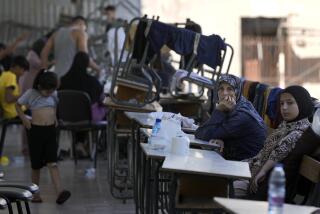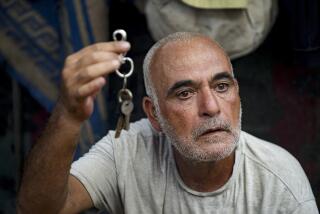Living With Loss in Afghan Camp
CAMP MASLAKH, Afghanistan — As Mohammed Ismail made his rounds just after sunrise, the cemetery at Maslakh camp was already busy. The gravediggers swung their picks, and the frozen gray earth was split open for four fresh graves.
In a typical week, 29 people die at this barren camp for internally displaced people in far western Afghanistan. Ismail, a displaced person himself, is paid to unearth the particulars of the dead--name, date and cause of death, home district and perhaps an estimated age.
By 10 a.m., Ismail had questioned the bereaved and learned that on this brutally cold day, a 3-day-old girl named Hawa died of a blood infection. A 10-day-old boy named Abdul Raziq died of a bacterial infection. A 65-year-old woman named Fatima died after a fall. And a 70-year-old named Khair Mohammed died for reasons unknown.
Both the dead and the living are obliged to remain in Camp Maslakh, carved out of a desert plateau in Herat province along the highway to Iran. A mile wide and more than three miles long, the camp is a rudimentary home to between 160,000 and 270,000 Afghan peasants who have been driven from their homes by a four-year drought.
By most estimates, Maslakh is either the largest or second-largest camp in the world for displaced people. Afghanistan has 950,000 displaced people within its borders, according to international relief agencies, and 6 million hungry people in a nation where 85% of the population relies on home-grown crops.
Maslakh is a place where residents swarm around any visiting Westerner, pleading for money, food or fuel. Children squat in the dirt for hours, waiting for their turn to race to kitchen windows for bowls of porridge. Human excrement smears the worn dirt pathways, where many residents walk barefoot in subfreezing temperatures. Children often fall into pits dug for latrines. Camp guards swat, with rope and rifle butts, at residents surging around the food distribution centers. Former Taliban fighters prowl the camp, residents say, and armed men have threatened aid workers.
So many people have made their way here from surrounding foothills and mountains that the camp directors fear it will become a permanent home for people grown dependent on donated food and shelter.
“There’s a real danger of depleting the countryside of its population,” said Rafael Robillard of the International Organization for Migration, which coordinates humanitarian assistance at the camp.
As wretched as life is in Maslakh, with its swirling dust and howling winds, it is preferable to what residents left behind. The drought has robbed them of their crops, their livestock, their homes and, for many, loved ones who died before they could escape.
“The wheat died, the cows died, people died. And now we fear we’re dying here at Maslakh,” said Mohammed Juma, who brought his family of eight to the camp nine months ago from Ghor province and lives now in a tent.
The graveyards are expanding and encroaching on the highway. There are four now, with gravediggers chipping away at a fifth. Roughly half of the untold number of dead are children under 5, according to the United Nations World Food Program.
Yet the infant mortality rate is slightly lower for the camp than for Afghanistan as a whole, said Alejandro Chicheri of the WFP. And a malnourished child has a far better chance of survival here than in the mountains, thanks to a food and medical program run by Doctors Without Borders, a private aid group. Among the camp’s 39,000 preschool-age children, only 75 to 85 are treated for severe malnutrition on a given day.
“It’s true that conditions at Maslakh are hardly ideal, but we are still getting people from two and three provinces away,” Chicheri said. “How do you make a safe, clean camp without attracting people from all over? That’s our Catch-22.”
To keep people in other provinces from coming here to avoid war and drought, the WFP and the International Committee of the Red Cross are concentrating food distribution in areas of endangered population in neighboring Ghor and Badghisj provinces. Officials plan to gradually shut down this site and move people to a new camp south of the city of Herat, the provincial capital. Maslakh is home to thousands of unregistered people and nomads who don’t qualify as internally displaced. The new camp will allow for proper screening and registration, officials say.
They also hope to control petty crime. Donated food and materials from Maslakh can be found for sale in Herat’s markets, and some people in the camp register more than once to obtain extra rations. Officials say factions of Northern Alliance fighters have competed for the right to collect baksheesh, or gratuities, from residents in return for a choice spot at the head of a line for food or wood stoves.
Maslakh’s population was just 100,000 in June. Many abandoned the camp after the U.S. bombing campaign began in October, then drifted back after fighting ended here in mid-November. Now thousands of residents have said that they want to return home. But winter snows have blocked mountain roads, and the drought makes spring planting a risk.
For now, Maslakh endures, a testament to the resiliency of a population that has been buffeted by 23 years of war.
Residents live in mud huts and tents with earthen floors, surviving on a 110-pound bag of wheat a month for each family. Except for those who hike into the mountains for hours to collect brush for firewood, there is little to do except wait until it is time to eat.
“We do nothing but spend our days sick and afraid,” said Amina, 58, who, like many Afghans, goes by one name. Amina arrived at the camp with her husband and six children two months ago after a four-day trip from Badghis. “But here we have food, and so we stay.”
From inside his vest pocket, camp resident Abdullah Jalal, 55, withdrew a red plastic wallet that contained a folded slip of paper. It listed children from his 23-member clan who had died at the camp since the family arrived nine months ago. There were eight, from day-old Zainab to year-old Mohammed to 8-year-old Hesamuddin.
There were more dead every day at the cemetery outside Camp One, one of several smaller camps that make up Maslakh. There, Mohammed Ismail dutifully registered the names of those in the new graves. He was pleased to have the job. A “grave enumerator,” as he is called, earns about $18 a month, a fine sum in Afghanistan. He has no idea how many people are buried at Camp One. “They come so fast I can’t keep up,” he said.
Ismail showed his lists of the recent dead to Dr. Ahmed Fahim, a camp physician. Fahim read aloud some of the typical causes of death: tuberculosis, hepatitis, diarrhea, malaria, exposure and respiratory tract infections. During a rare series of rainstorms last month, 70 people died in flash floods, Fahim said.
Behind the doctor’s office lay a deep hole into which the gravediggers lowered Fatima, the 65-year-old woman who died after a fall. Her body had been washed and wrapped in a white funeral shroud by family members; Fahim said a new camp mortuary will provide such services.
Fatima was buried according to Muslim custom, with her head to the north and her face to the west. After the gravediggers packed Fatima’s shrouded body with mud and shoveled the dirt back into the grave, male relatives piled stones atop the burial mound. They added broken glass to discourage camp boys from taking the stones.
Like most families, Fatima’s survivors placed a large gray stone at the head and foot of the grave, linking the two with a strand of cloth torn from the shroud.
Ismail stood to the side as an imam led prayers, chanting verses from the Koran. One of the dead woman’s sons, Hayatullah, reached out and touched her grave with his forefinger as he prayed. Another son, Mehraban, was offered condolences and said: “Everyone dies. We all must die.”
The imam finished the prayers and the mourners chanted the Dari word ahmeen, amen. It was only after the mourners left, driven back to their huts by a punishing winter wind, that the two sons of Fatima allowed themselves to bow their heads and weep.
More to Read
Sign up for Essential California
The most important California stories and recommendations in your inbox every morning.
You may occasionally receive promotional content from the Los Angeles Times.











